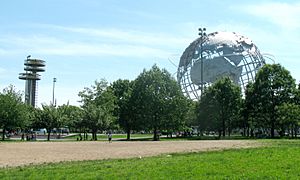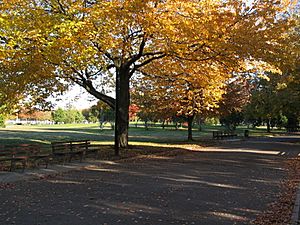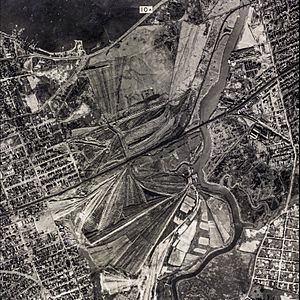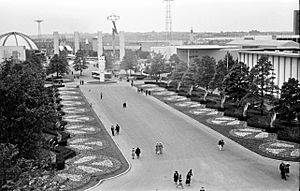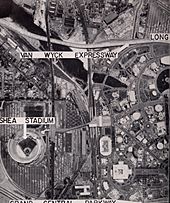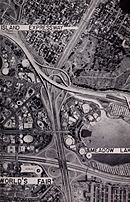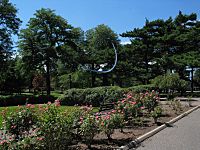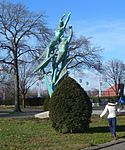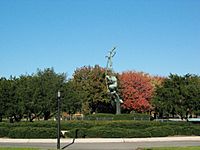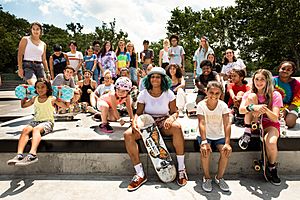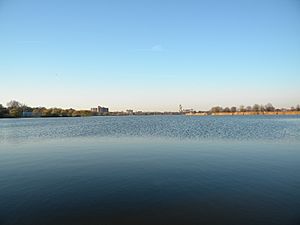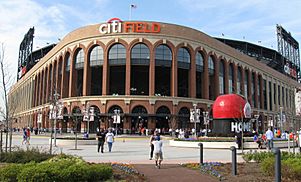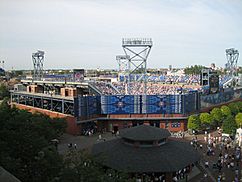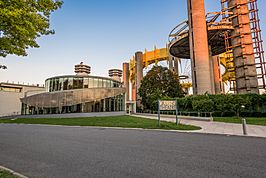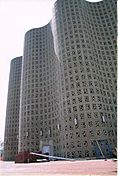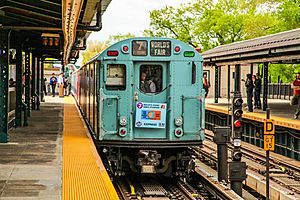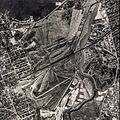Flushing Meadows–Corona Park facts for kids
Quick facts for kids Flushing Meadows–Corona Park |
|
|---|---|
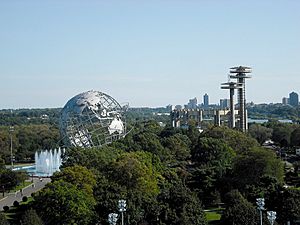
The Unisphere and the New York State Pavilion
|
|
| Type | Public park |
| Location | Queens, New York, United States |
| Area | 897 acres (363 ha) |
| Created | 1939 |
| Operated by | NYC Parks |
| Status | Open all year |
| Public transit access | Subway: LIRR: Port Washington Branch to Mets–Willets Point Bus: Q48, Q58, Q64, Q88 |
Flushing Meadows–Corona Park is a big public park in Queens, New York City. People often call it Flushing Meadows Park or just Flushing Meadows. It is surrounded by major roads like the Van Wyck Expressway and the Grand Central Parkway. To the north is Flushing Bay, and to the south is Union Turnpike. This park is the fourth-largest public park in New York City, covering about 897 acres (363 ha).
For a long time, this area was mostly wetlands. In the early 1900s, it became a huge dumping ground for ashes and garbage. But then, Robert Moses, who was in charge of New York City's parks, had an idea. He wanted to turn this messy area into a beautiful park. Flushing Meadows–Corona Park was created especially for the 1939 New York World's Fair. It also hosted the 1964 New York World's Fair. After the 1964 fair, the park needed a lot of care, but many improvements have been made since the 1990s.
The park still looks a lot like it did during the 1939 World's Fair. Today, it has many cool attractions. These include the USTA Billie Jean King National Tennis Center, where the famous US Open tournament happens. You can also find Citi Field, which is the home stadium for the New York Mets baseball team. Other fun places are the New York Hall of Science, the Queens Museum, the Queens Theatre in the Park, and the Queens Zoo. The giant Unisphere globe is also a famous landmark here. The Flushing River still flows through the park, and there are two large lakes, Meadow Lake and Willow Lake, in the southern part of the park.
The New York City Department of Parks and Recreation (NYC Parks) owns and takes care of Flushing Meadows–Corona Park. Some non-profit groups, like the Flushing Meadows–Corona Park Conservancy, also help by providing money and support to keep the park great.
Contents
What's in a Name?
The park gets its name from the nearby neighborhoods of Flushing and Corona. These two areas are separated by the park itself. The name "Flushing" comes from a Dutch port town called Vlissingen. By the 1800s, "flushing" also meant "a cleansing by rushing water." The name "Corona" was added to the park's name right before the 1964 New York World's Fair.
Park History
From Wetlands to World's Fairs
For thousands of years, what is now Flushing Meadows Park was a wetland and a salt marsh. This area was formed by giant sheets of ice during the Ice Ages. The Flushing River flowed through it, and it was home to many animals like waterfowl and fiddler crabs.
Native American groups, like the Lenape people, lived in this area first. Then, in the 1600s, Dutch settlers arrived and created towns like Newtown and Flushing. The wetlands became known as the Corona Meadows. By 1666, European settlers had taken over the land. The meadows were important for settlers because they provided wood, water, and good soil for farming. During the American Revolution, a British army headquarters was located here.
In the 1800s, simple roads and even railroads were built through the meadows. Because of its natural beauty, the area became a popular place for wealthy New Yorkers to build homes.
The "Valley of Ashes"
Around 1907, a builder named Michael Degnon bought large parts of the marshland. He wanted to create a big industrial port around Flushing Bay. To do this, he started filling the land with ashes from homes and street sweepings from Brooklyn. This dumping continued for nearly 30 years. About 50 million cubic yards of ash and waste were dumped here! One huge pile of ash was even called "Mount Corona."
This dumping ground became known as the Corona Dump or Corona Ash Dumps. It caused many problems for local residents, including bad smells and lots of rats. The famous writer F. Scott Fitzgerald described it as "a valley of ashes" in his book The Great Gatsby.
Planning the Park and World's Fairs
In the 1920s, Parks Commissioner Robert Moses had a big idea. He wanted to turn the ash dump into a huge park, like a "true Central Park" for Queens. In 1935, the site was chosen for the 1939 New York World's Fair.
Work on the fairgrounds began in 1936. Workers leveled the ash mounds and used the leftover material to fill other parts of the meadow. They dug out two areas to create Meadow Lake and Willow Lake. Much of the Flushing River was moved underground. Thousands of trees were planted to make the area look natural. The park's design, with its wide pathways, was kept from the fair.
Many of the major roads around the park, like the Van Wyck Expressway and the Long Island Expressway, were built using some of the ash and refuse from the dumps as their base. This idea of turning old dumps into parks was also used for other parks in New York City.
After the 1939 World's Fair closed, the site was supposed to become a city park. But World War II delayed these plans. From 1946 to 1951, some of the old fair buildings were even used as the first temporary headquarters for the United Nations. The building that housed the Queens Museum today was once the UN General Assembly hall!
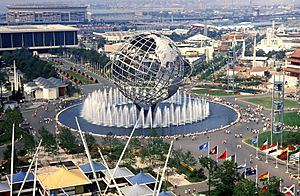
In 1959, Flushing Meadows was chosen to host another big event: the 1964 New York World's Fair. New structures were built, including the famous Unisphere, Shea Stadium, and the New York Hall of Science. These were meant to be permanent attractions for the park. In 1964, the New York City Council officially added "Corona" to the park's name, making it "Flushing Meadows–Corona Park." After the fair, the site was finally turned into the public park we know today, opening on June 3, 1967.
Recent Years
Even after the 1964 fair, the park still needed a lot of work. There wasn't enough money to make all the improvements that were planned.
In 1978, the US Open tennis tournament moved to Flushing Meadows–Corona Park. The Louis Armstrong Stadium, which was a building from the 1964 World's Fair, was updated for the tournament.
Since the 1990s, parts of the New York State Pavilion have become popular with skateboarders. In 2010, a special skate plaza was built nearby for skateboarding competitions.
In the 2000s and 2010s, many improvements were made. A large indoor pool and ice skating rink, called the Flushing Meadows Natatorium, opened in 2008. Citi Field, the new baseball stadium, opened in 2009. There are also plans to restore the New York State Pavilion and other parts of the park.
Since 2015, the park has hosted the Queens Night Market, a popular food market where you can try foods from many different countries.
Park Layout and Nature
Park Design
The design of Flushing Meadows–Corona Park still follows the plans from the 1939 and 1964 World's Fairs. The northern part of the park, where the fairs were held, has wide paved paths that once led to big buildings, fountains, and sculptures. The Unisphere and the Queens Museum are at one end of the main pathway. In the middle of this path are the Fountains of the Fairs. This design helped guide fair visitors to all the exhibits. Many areas where exhibits once stood are now used as soccer fields or open grassy areas.
The southern part of the park is mostly taken up by Meadow Lake and Willow Lake. The Flushing River flows through both lakes. The land around Meadow Lake has open grass, picnic areas, and fields for baseball and cricket. The Willow Lake area is a nature reserve, meaning it's a protected place for plants and animals.
The park is surrounded by highways built by Robert Moses, like the Van Wyck Expressway and the Grand Central Parkway. The Long Island Expressway cuts through the middle of the park, dividing it into northern and southern halves. Getting to some parts of the park can be tricky because of the highways and limited public transportation.
Park Size
Flushing Meadows–Corona Park is the fourth-largest public park in New York City. It was once thought to be much larger, but a survey in 2013 found its actual size to be about 897 acres (363 ha).
Park Ecology
The two lakes and the Flushing Creek are separated by a special gate called the "Tide Gate Bridge." This gate lets water flow north towards Flushing Bay but stops water from flowing south. This helps keep the lakes fresh water.
However, the lakes can sometimes have problems with pollution and too many nutrients from the old marshland, which can harm the fish. The park's lakes are home to different fish species, including American eel and largemouth bass. Willow Lake is named for the many Willow trees that grow there. Many types of birds also visit the park, especially during migration.
Things to See and Do
Attractions
Near the northern end of the park is the "Sport Center" area. This is where the US Open tennis tournament is held at the USTA Billie Jean King National Tennis Center. It has two main stadiums: Arthur Ashe Stadium and Louis Armstrong Stadium.
Citi Field, the home of the New York Mets baseball team, is also at the far north end of the park. The Mets' old stadium, Shea Stadium, used to be right next to it.
Meadow Lake has a boat house, which is one of the original buildings from the 1939 World's Fair. You can rent boats there for rowing and paddleboating. Meadow Lake is also where teams practice for the annual Hong Kong Dragon Boat Festival in New York. There are also bike paths around Meadow Lake that connect to other trails. The Willow Lake Trail, a nature path, was reopened in 2013. The park's many sports fields and playgrounds are used for popular activities like soccer and cricket.
Some buildings from the World's Fairs are still in use today. The Flushing Meadows Carousel, from the 1964 Fair, is in the park's northwestern part. The New York Hall of Science, which opened during the 1964 World's Fair, is one of the country's first science museums. The New York State Pavilion, with its cool towers, is also a famous part of the park, even though it's not used anymore. Next to it is the Queens Theatre in the Park, which was originally a fair attraction. Terrace on the Park, a banquet hall, was once the fair's helipad. The Queens Museum was the New York City Pavilion during the 1964 fair and now houses a huge model of New York City called the Panorama.
The Playground for All Children is also in the park. It was one of the first playgrounds designed to be accessible for kids with disabilities.
Transportation in the Park
You can get to the northern part of the park by New York City Subway and Long Island Rail Road. The Mets–Willets Point subway station (7 <7> trains) and the LIRR station serve Citi Field and the tennis center. The 111th Street subway station is also close to the New York Hall of Science. Several city buses also travel through or near the park.
Images for kids
See also
 In Spanish: Parque Flushing Meadows-Corona para niños
In Spanish: Parque Flushing Meadows-Corona para niños


